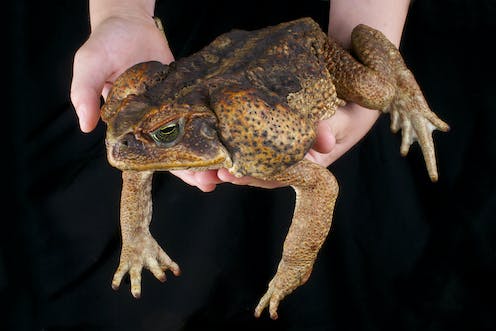
Cane toads: very large, very invasive and very poisonous. reptiles4all/iStock via Getty Images Plus
When large and warty cane toads were first brought to Australia nearly 100 years ago, they had a simple mission: to gobble up beetles and other pests in the sugarcane fields.
Today, though, the toads have become an infamous example of a global problem: biocontrol initiatives gone wrong. The squat creatures have spread across the top half of the country, wreaking havoc on ecosystems. Cane toads are highly toxic, and consuming just one is generally lethal for predators like monitor lizards, freshwater crocodiles and the small, spotted marsupials called quolls.
But what if you taught other animals not to eat the toads? Could you – and should you?
Conservation behavior scientists are doing just that. One of the most exciting areas in this quickly evolving field is behavior-based management, in which an animal’s behavior is encouraged, modified or manipulated in some way to achieve positive conservation outcomes.
In Australia, scientists are working with Indigenous rangers to teach predators not to eat cane toads. Next door in New Zealand – or Aotearoa, in the Indigenous Māori language – researchers, including one of us, Catherine Price, have used fake scents to condition ferrets, hedgehogs and other predators to ignore endangered birds’ eggs. Other behavior-based management efforts include re-teaching lost migratory routes to birds in North America, preparing captive animals for life in the wild in Colombia and using deterrents like colored flags to keep wildlife away from sites where they might conflict with humans.
This research has significant potential to conserve threatened species and reduce animal deaths. However, modifying behavior may come at a cost to animals or the communities they live in.
We are scientists and philosophers who study conservation and the ethical dilemmas involved in modifying animal behavior. Working with colleagues, we have developed a framework to help researchers evaluate the ethical considerations of conservation behavior interventions against other options.
Humane solutions
One important dimension of behavioral interventions is their potential to conserve species and ecosystems without shooting, poisoning or trapping animals that people view as problems, which has become standard practice in many parts of the world. This is particularly appealing in cases where the animal is endangered.
Elephants, for example, are often killed by accident or on purpose when they wander into human environments like farmers’ fields or railroads. In Kenya, farmers and researchers have built “bee fences” that use elephants’ fear of bees to keep them out of crops.
A woman pays tribute to a dead elephant that was hit by a train in northeastern India.
Str/Xinhua via Getty Images
There are a growing number of other contexts in which it is impractical, publicly unacceptable or just undesirable to kill some animals in order to conserve others, or to achieve other wildlife management goals – like keeping seals away from salmon farms or coyotes out of suburbs. Behavioral interventions are increasingly viewed as a more ethical conservation and wildlife management possibility.
Ethical questions
While we think there is great potential, behavior-based interventions also open up new ethical questions, or raise old questions in new ways.
Some concern animal welfare. While avoiding poisoning or shooting animals can reduce overall harm, behavioral management may generate other forms of harm. For example, using aversive stimuli such as loud noises, harassment or mild pain to train species to avoid an area may cause distress and even trauma. In other cases, there are incidental harms to other species, such as animals killed to be used as “bait” in behavioral interventions.
Changing an animal’s behavior may impact local communities’ livelihoods and cultural practices, too, whether for good or ill – like ranchers and farmers asked to use scent “biofences” to keep predators away from their livestock.
What’s more, some people believe deliberately modifying animal behaviors is unacceptable. To take one iconic example, as California condors neared extinction in the wild, some conservationists pushed for intensive interventions and captive breeding. Others were so strongly opposed that they viewed extinction as preferable, arguing that the condor was “better dead than bred.”
A California condor tagged No. 19 drifts over the Colorado River, seen from Navajo Bridge near Marble Canyon, Arizona.
Carolyn Cole/Los Angeles Times via Getty Images
Another potentially significant issue is what we have named “behavioral bycatch”: all the costs for organisms unintentionally caught up in a behavior-based management project. For example, some fish farms have tried to prevent seals from eating their fish by using a device that plays an unpleasant sound: a seal’s version of “fingernails on a chalkboard.” But in one study, scientists discovered that toothed whales were even more sensitive to the sound and less likely to adjust to it. As a result, these “non-target” animals may be more prone to abandoning the area than the target animals.
Weighing values
We argue that in order to make wise decisions, wildlife managers need to identify the diverse values at stake in a given situation. This might involve cultural and heritage values – such as the significance of hunting in an Indigenous culture – as well as economic and aesthetic values. It will also likely include the welfare of individual animals, the health of ecosystems and perhaps animals’ ability to live with minimal interference.
Together, we developed a framework to help identify and discuss these sometimes conflicting values in any given situation. The value of boosting one endangered species’ breeding success, for example, might need to be considered against the suffering of other individual animals caught up in the intervention process.
We then created a series of steps to support conservation workers as they compare and contrast the ethical dimensions of possible behavior-based management approaches and decide on the best course of action. It is key for managers to be clear about what a proposed intervention is trying to achieve and how likely it is to meet that goal. Next is weighing the potential effects on a broader range of species, including people: For example, might it enable a sustainable agricultural harvest?
These resources are not intended to provide definitive answers. However, they allow researchers to focus on some of the key potential impacts, then compare these to other methods that might be attempted. Today, virtually all conservation challenges have a human dimension, and it’s important to recognize that the most effective solutions may involve changing people’s behavior, not animals’ – like controlling human food waste to discourage “problem bears.”
Ultimately, we see great value in conservation behavioral interventions, but also some challenges. We hope slowing down to consider the values at stake in conservation behavior interventions will help minimize harm and maximize benefits – to both humans and wildlife.
Daniel T. Blumstein receives funding from the National Science Foundation. He is chief editor of Frontiers in Conservation Science.
Catherine Price receives funding from the Australian Research Council.
Thom van Dooren receives funding from the Australian Research Council.
Advertisement

Advertisement
Contact Us
If you would like to place dofollow backlinks in our website or paid content reach out to info@qhubonews.com











